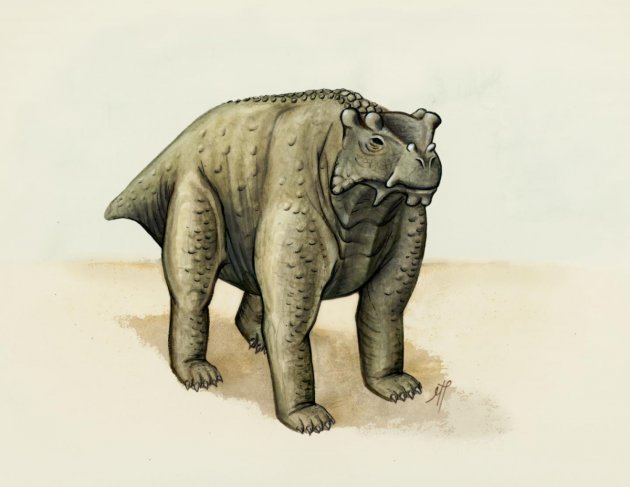With all the talk about SETI (Search for Extra Terrestrial Intelligence) we have to remember that scientists still do not know everything about Earth.
We are told "Man" -or, rather, "Humans"- originated in such-and-such a place and most of us are probably familiar with the illustrated Evolution of Man charts -that we have to keep adding to -recently Homo naledi http://terryhooper.blogspot.co.uk/2015/09/new-species-of-human-discovered-in.html

Whether pre-human remains, remains of ancient civilisations (as in Amazonia) and contact between countries once deemed "impossible" before Columbus (??) things buried in the ground or even submerged underwater, stay there until, in many cases, they are stumbled upon.
How many now extinct newly discovered species have there been over the last twenty years? Let's say "a bunch" for convenience.
And now this....but it is not the definite first quadruped. Saying that means you look a bit daft when another is found. Nothing should ever be taken for granted and I'm sure in coming years we'll get even more surprises and "firsts"!
Connor Gaffey for Newsweek https://uk.news.yahoo.com/cow-size-pre-reptile-may-110829245.html#gnk6FJB

Scientists believe that a pre-reptile, which lived 260 million years ago, may have been the first animal to walk on four legs.
Analysis of fossils from the Bunostegos akokanensis, which were discovered in Niger between 2003 and 2006, show that its forelimbs were uniquely designed to allow the animal to stand upright in the manner of a cow.
The fossils belong to a group of pre-reptiles known as pareiasaurs—the first group of large land vertebrates which flourished during the Permian period, a geological period which lasted from 299 million to 251 million years ago. All of the known pareiasaurs were sprawlers, with limbs similar to modern lizards that would jut out from the sides of the body.
However, B. akokanensis had a number of distinct features which means it would have resembled "a cow-sized, plant-eating reptile with a knobby skull and bony armor down its back," according to Linda Tsuji from the Royal Ontario Museum, a co-author of the study published in the Journal of Vertebrate Paelontology.
The creature's elbow joint is a hinge joint—similar to the human
knee, meaning it can only swing back and forth and precluding the
sideways movement characteristic of spralwers. Finally, the fossil's
ulna—a bone in its forearm—is longer than the humerus, which the
researchers said is a common-trait in non-sprawling animals.
We are told "Man" -or, rather, "Humans"- originated in such-and-such a place and most of us are probably familiar with the illustrated Evolution of Man charts -that we have to keep adding to -recently Homo naledi http://terryhooper.blogspot.co.uk/2015/09/new-species-of-human-discovered-in.html

Whether pre-human remains, remains of ancient civilisations (as in Amazonia) and contact between countries once deemed "impossible" before Columbus (??) things buried in the ground or even submerged underwater, stay there until, in many cases, they are stumbled upon.
How many now extinct newly discovered species have there been over the last twenty years? Let's say "a bunch" for convenience.
And now this....but it is not the definite first quadruped. Saying that means you look a bit daft when another is found. Nothing should ever be taken for granted and I'm sure in coming years we'll get even more surprises and "firsts"!
Connor Gaffey for Newsweek https://uk.news.yahoo.com/cow-size-pre-reptile-may-110829245.html#gnk6FJB

Scientists believe that a pre-reptile, which lived 260 million years ago, may have been the first animal to walk on four legs.
Analysis of fossils from the Bunostegos akokanensis, which were discovered in Niger between 2003 and 2006, show that its forelimbs were uniquely designed to allow the animal to stand upright in the manner of a cow.
The fossils belong to a group of pre-reptiles known as pareiasaurs—the first group of large land vertebrates which flourished during the Permian period, a geological period which lasted from 299 million to 251 million years ago. All of the known pareiasaurs were sprawlers, with limbs similar to modern lizards that would jut out from the sides of the body.
However, B. akokanensis had a number of distinct features which means it would have resembled "a cow-sized, plant-eating reptile with a knobby skull and bony armor down its back," according to Linda Tsuji from the Royal Ontario Museum, a co-author of the study published in the Journal of Vertebrate Paelontology.
The fossils, show that the humerus of B. akokanensis
was straight, in contrast to the twisted humerus possessed by
sprawlers. Its shoulder joint points directly downwards, suggesting a
straight alignment of bones underneath.
Researchers believe that the
pre-reptile's upright posture could have helped it in finding food in
its arid environs. Compared to sprawling, walking upright on four legs
is associated with a more energy efficient posture and may have helped B. akokanensis conserve energy on long journeys between meals.

No comments:
Post a Comment